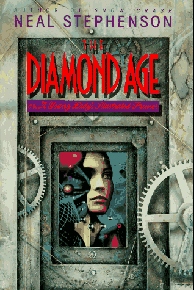Four great books to read on the plane

Katie Roiphe over at Slate has distilled down criteria for the perfect airplane book: it should be "effortlessly transporting" (so that you are whisked away from the reality of being on an airplane), "long or at least longish" but not slow and meandering (Proust would probably not be a good choice), and it should be gripping (to keep your attention) but not "too exciting or terrifying" (because travel is already stressful and/or frightening enough).
When it comes to airplane reading, I tend to gravitate towards science fiction and fantasy. There is a lot of great literature out there, but stuck in a cramped seat at 30,000 feet is not the time to contemplate the mysteries of the human condition. What science fiction and fantasy books may lack in gravitas, they gain in world-building and narrative momentum. And those just happen to be the two things you need most, as you're trying to ignore the elbow fight for the arm rest, or the way the drinks cart keeps bashing you in the shoulder as it wobbles past.
At the same time, science fiction and fantasy novels tend to be large and weighty enough to carry you through an entire flight and beyond. Unlike the works of, say, Carl Hiaasen, which are entertaining and engrossing, but over far too soon.
Given these exacting criteria, here are my choices for the best books to take on a plane ride.
The Diamond Age
Neal Stephenson
This steampunk-before-steampunk-was-cool novel follows a young girl in a post-scarcity neo-Victorian future who is essentially being raised by an AI. The Diamond Age deals with interesting issues of class and privilege in a way that Stephenson's other books don't.
Tough call between this, Snow Crash, and Cryptonomicon. Both books are masterpieces of contemporary science fiction, and both are starting to show their age as technology rushes forward. But all three books are long (but not so long as his more recent books) and gripping (much more so than his recent works). And of the three, I feel that The Diamond Age is most often overlooked and underappreciated.
The Stand
Stephen King
King's novel of the Influenza Apocalypse is just as timely today as it was in the 80s. The novel switches between a large cast of characters as they navigate the post-disaster world, trying to pick up the pieces of civilization.
This is a pretty decent book to read on an airplane. Not such a great choice to read when you are sick. And maybe you don't want to think about the mechanics of cross-country germ transmission. But if you are okay with that element of it, The Stand is a thoroughly engaging book that moves along at a face pace. (Get the unabridged version if possible.)
The His Dark Materials series
Phillip Pullman
This alternate universe YA fantasy series is set in a world where people's souls are enshrined as an external animal (their familiar), and the church controls everything - including the flow of magic.
Okay I'm cheating a little here, but you can frequently buy all three His Dark Materials novels in a single collected volume, and they do work best when read as one large book in three pieces. When it comes to YA lit and fantasy fiction, the His Dark Materials series has fascinating world-building and an epic story. Unlike the Harry Potter series His Dark Materials also features a good female protagonist, and tackles a lot of weighty issues. Much more bang for your buck.
Interview with the Vampire
Anne Rice
This gothic horror novel is told mainly in flashback, recapping the life of former plantation owner turned vampire Louis de Pointe du Lac. The novel follows Louis as he is turned into a vampire by Lestat, and along with the child vampire Claudia forms a strange, utterly dysfunctional vampire family cutting a swath through eastern Europe and Parisian high society.
This is basically the book that started it all, launching a powerful trend of super-sexy vampires with flexible gender orientation. If you have never read it, or if you haven't read it recently, I highly recommend it. It's true that Rice's language can be needlessly ornate, but this early Rice novel moves along at a brisk clip, unlike some of her later works.
Image copyright Neal Stephenson

2 comments